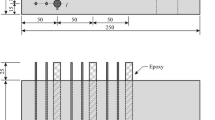Abstract
A model of damage to fresh concrete in a corrosive sulphate environment was formulated to investigate how and why the strength of corroded concrete changes over time. First, a corroded concrete block was divided into three regions: an expanded and dense region; a crack-development region; and a noncorroded region. Second, based on the thickness of the surface corrosion layer and the rate of loss of compressive strength of the corroding region, a computational model of the concrete blocks’ corrosion-resistance coefficient of compressive strength in a sulphate environment was generated. Third, experimental tests of the corrosion of concrete were conducted by immersing specimens in a corrosive medium for 270 d. A comparison of the experimental results with the computational formulae shows that the calculation results and test results are in good agreement. A parameter analysis reveals that the corrosion reaction plays a major role in the corrosion of fresh concrete containing ordinary Portland cement, but the diffusion of the corrosion medium plays a major role in the corrosion of concrete mixtures containing fly ash and sulphate-resistant cement. Fresh concrete with a high water-to-cement ratio shows high performance during the whole experiment process whereas fresh concrete with a low water-to-cement ratio shows poor performance during the late experiment period.
Similar content being viewed by others
References
TIXIER R, MOBASHER B. Modeling of damage in cement-based materials subjected to external sulfate attack. II: Comparison with experiments [J]. Journal of Materials in Civil Engineering, 2003, 15(4): 314–322.
JAMES R C, JAMES M. Ponnersheim. Sulfate attack of cementitious materials: Volumetric relations and expansions [R]. Gaithersburg: Building and Fire Research Laboratory, National Institute of Standards and Technology, 1994.
KUMAR S, RAO C V S. Sulfate attack on concrete in simulated cast-in-situ and precast situations [J]. Cement and Concrete Research, 1995, 25(1): 1–8.
KUMAR S. Influence of water quality on the strength of plain and blended cement concretes in marine environments [J]. Cement and Concrete Research, 2000, 30(3): 345–350.
CASTRO P, VELEVA L, BALANCAN M. Corrosion of reinforced concrete in a tropical marine environment and in accelerated tests [J]. Construction and Building Materials, 1997, 11(2): 75–81.
CRAMMOND N J, COLLETT G W, LONGWORTH T I. Thaumasite field trial at Shipston on Stour: Three-year preliminary assessment of buried concretes [J]. Cement & Concrete Composites, 2003, 25(8): 1035–1043.
WANG Chao-cheng. Adaptability experimental research of the filling pile in strong sulphate corrosive environment [D]. Lanzhou: Lanzhou University, 2011. (in Chinese)
LONG Guang-cheng, XIE You-jun, DENG De-hua, LI Xiao-kun. Deterioration of concrete in railway tunnel suffering from sulfate attack [J]. Journal of Central South University of Technology, 2011, 18(3): 881–888.
LONG Guang-cheng, XIE You-jun, TANG Xu-guang. Evaluating deterioration of concrete by sulfate attack [J]. Journal of Central South University of Technology, 2007, 22(3): 572–576.
YUAN Xiao-lu, LI Bei-xing, CUI Gong, ZHAO Shang-chuan, ZHOU Ming-kai. Grey clustering theory to assess the effect of mineral admixtures on the cyclic sulfate resistance of concrete [J]. Journal of Wuhan University of Technology: Materials Science, 2010, 25(2): 316–318.
DONG Qing-you, ZHANG Yin-hua, FENG LI-PING, JIN De-bao, ZHANG Jing-shu, WANG Chao-cheng. Experimental research of sulfate corrosion resistance of fresh concrete with fly ash [J]. Advanced Materials Research (International), 2013, 772: 109–116.
ZHANG Jing-shu, ZHANG Yin-hua, FENG Li-ping, DONG Qing-you, WANG Chao-cheng. Corrosion resistant coefficient of concrete compressive strength under sulphate environment [J]. Journal of Building Materials, 2014, 17(3): 371–379. (in Chinese)
TIXIER R, MOBASHER B. Modeling of damage in cement-based materials subjected to external sulfate attack. I: Formulation [J]. Journal of Materials in Civil Engineering, 2003, 15(4): 305–313.
IDIART A E, LÓPEZ C M, CAROL I. Chemo-mechanical analysis of concrete cracking and degradation due to external sulfate attack: A meso-scale model [J]. Cement and Concrete Composites, 2011, 33(3): 411–423.
LEEMANN A, LOSER R. Analysis of concrete in a vertical ventilation shaft exposed to sulfate-containing groundwater for 45 years [J]. Cement and Concrete Composites, 2011, 33(1): 74–83.
GB/T50082-2009. Standard for test methods of long-term performance and durability of ordinary concrete [S]. Beijing: China Architecture & Building Press, 2009. (in Chinese)
LI Shi-wei, WANG Ying-fei, WANG Sheng-nian. Research on the prediction model of the concrete damage in the sulfate aggressive environment [J]. Journal of Wuhan University of Technology, 2010, 32(14): 35–39. (in Chinese)
CAO Shuang-yin. Mechanical properties of corroded concrete [J]. Journal of Southeast University, 1991, 21(4): 89–95. (in Chinese)
CHEN Yuan-su, LI Xin, FAN Ying-fang. Test research on the salt corrosion concrete compressive strength [C]// Proceedings of the 15th Nationwide Academic Conference on Structural Engineering (II). Beijing: The Engineering Mechanics Editorial Department of CSTAM, 2006: 5–10. (in Chinese)
WANG Zong-qin, ZHU Shou-quan, YU Ren-pei. China saline soil [M]. Beijing: Science Press, 1993. (in Chinese)
LEVENSPIEL O. Chemical reaction engineering [M]. New York: Wiley, 1972.
Author information
Authors and Affiliations
Corresponding author
Additional information
Foundation item: Project(51078176) supported by the National Natural Science Foundation of China; Project(JK2010-58) supported by the Construction Science and Technology Research Project in Gansu Province, China
Rights and permissions
About this article
Cite this article
Zhang, Js., Zhang, Yh., Feng, Lp. et al. Damage model of fresh concrete in sulphate environment. J. Cent. South Univ. 22, 1104–1113 (2015). https://doi.org/10.1007/s11771-015-2622-7
Received:
Accepted:
Published:
Issue Date:
DOI: https://doi.org/10.1007/s11771-015-2622-7




